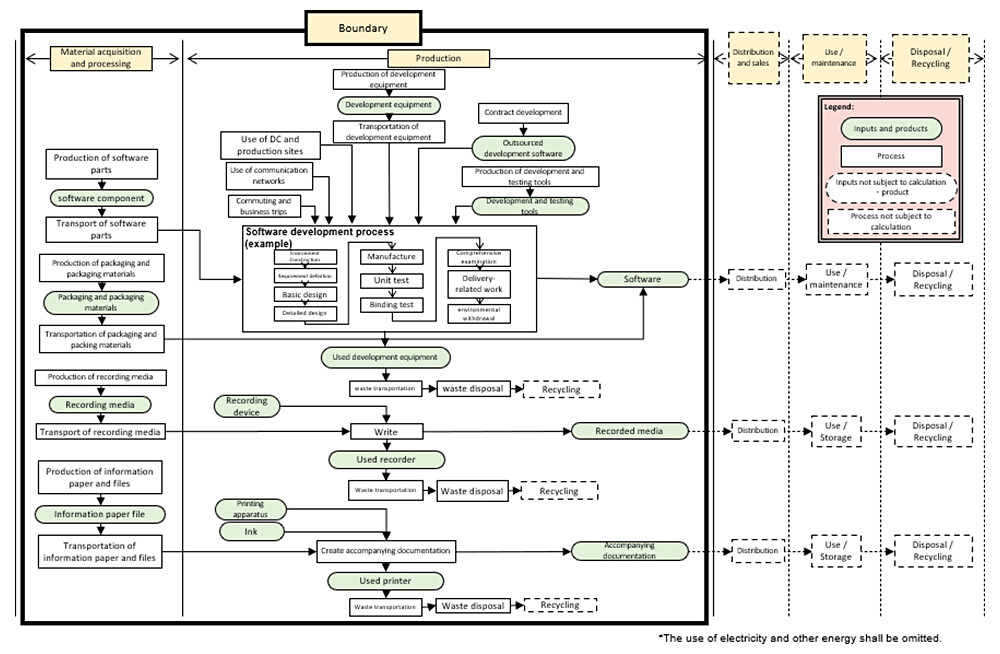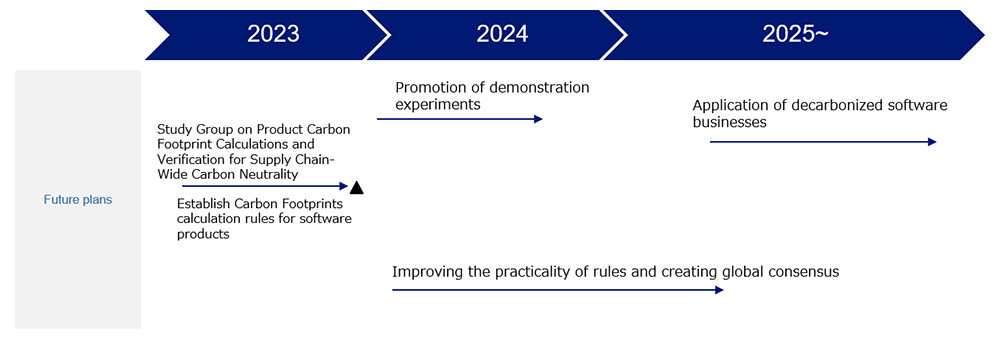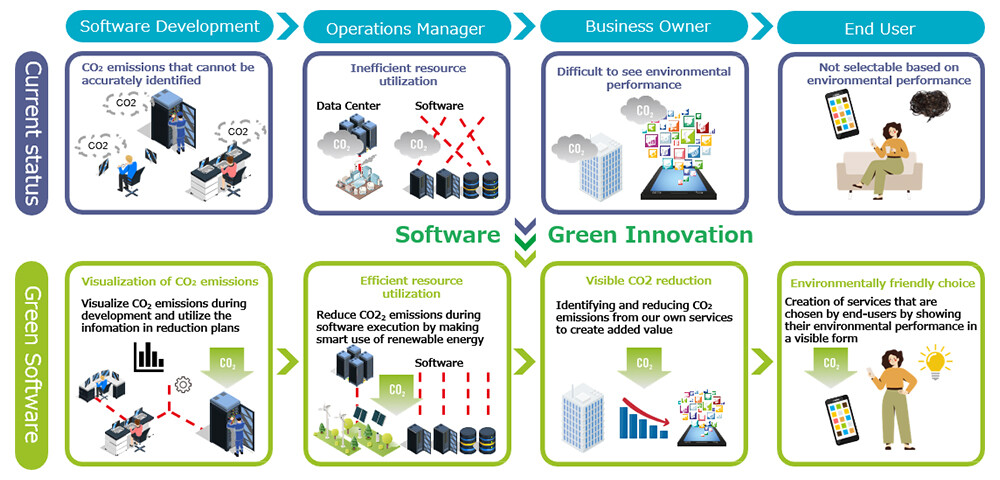Microsoft ends support for Internet Explorer on June 16, 2022.
We recommend using one of the browsers listed below.
- Microsoft Edge(Latest version)
- Mozilla Firefox(Latest version)
- Google Chrome(Latest version)
- Apple Safari(Latest version)
Please contact your browser provider for download and installation instructions.
March 29, 2024
NTT Corporation
Development of Carbon Footprint Calculation rules for software products
Decarbonize the software industry and reduce emissions throughout the supply chain
News Highlights:
- Based on NTT's knowledge of green software development and operation technologies and experimental data, we developed a rule for calculating the CO2 emissions of contract development software products.
- This rule is consistent with the "Carbon Footprint Guidelines" of the Ministry of Economy, Trade and Industry.
- Through the realization of green procurement of software products in the world, we will contribute to the reduction of CO2 emissions in the entire supply chain.
Tokyo - March 29, 2024 - As part of its efforts to decarbonize the software sector, NTT Corporation (NTT), together with NTT DATA Group Corporation, NTT Advanced Technology Corporation, NTT TechnoCross Corporation, NTT COMWARE CORPORATION, Ltd., QUNIE CORPORATION, Hitachi, Ltd., NEC Corporation, and Fujitsu Limited, has developed calculation rules that can reflect the efforts of developers to reduce CO2 emissions of contract software products.1 This calculation rule enables calculation and comparison of the CO2 emissions of contract development software products under the "Carbon Footprint Guidelines" of the Ministry of Economy, Trade and Industry.2
We will continue to develop these rules and contribute to the carbon neutrality of our supply chain.
1. Background
Power consumption and CO2 emissions in the ICT industry are increasing, and their share of global power consumption is projected to exceed 20% in 2030.3 The establishment of the Green Software Foundation4 by the world's leading software-related companies to reduce CO2 emissions has raised the importance of reducing CO2 emissions in the software field. NTT has been engaged in R&D of green software development and operation technologies for decarbonizing the software sector and has been promoting the development of guidelines for visualization and reduction of CO2 emissions from software and their dissemination within the NTT Group.
In recent years, there has been a growing interest in the calculation and disclosure of CO2 emissions in product level, and the need for creating a market where green products are selected based on the calculation and reduction of CO2 emissions throughout the supply chain, including Scope 3 in addition to Scope 1 and 2 of the GHG Protocol. However, with regard to the calculation of CO2 emissions of software products, a problem was that no standard calculation method was established other than the calculation on a monetary basis using the information on development costs, and it was difficult to reflect the reduction efforts of developers. Therefore, together with companies with a similar awareness of issues, in August 2023, we participated in the Ministry of Economy, Trade and Industry's Study Group on Product Carbon Footprint Calculations and Verification for Supply Chain-Wide Carbon Neutrality5 (hereinafter referred to as the Study Group), which was an open call for applications, and have been working to examine calculation rules for software products.
2. Results
As one of the first calculation rules consistent with the "Carbon Footprint Guidelines" of the Ministry of Economy, Trade and Industry.2, we have established a calculation rule for the amount of CO2 emissions from contract development software products. This calculation rule applies to the calculation of CO2 emissions at the software development stage, covering the period from order receipt to production. We believe that this would be the basis for calculating the amount of CO2 emissions from software products and that we have taken the first step toward realizing green procurement of software products.
3. Key points of the calculation rules
As an initial study, we proceeded with the examination of calculation rules based on contracted software products. Since contract development software products are manufactured based on product-specific requirements, CO2 emissions generated during development are mainly due to developers' activities. Therefore, it is not easy to grasp the amount of activity in the calculation of CO2 emissions compared to mass-produced products such as tangible industrial products. The two key points of the calculation rules we established are as follows.
- Systematization of calculation processes and emission sources specific to software development
We conducted a life cycle analysis of the development stage in terms of CO2 emissions and defined the processes and emission sources to be calculated. In addition, we defined a method to link the electricity consumed by the equipment and facilities used by the developer to the individual software products to be developed. These methods enable calculations that reflect the reduction efforts of the developer. We believe that the content and approach outlined in this rule will serve as a foundation for expanding the scope of the application. - Dealing with calculations and comparisons before software production
In addition to the basic requirements for the calculation of CO2 emissions set forth in the Ministry of Economy, Trade and Industry's "Carbon Footprint Guidelines"2, this calculation rule specifies requirements for when emissions are expected to be compared. We have enabled comparison of CO2 emissions calculated using design values, assuming calculation and disclosure of CO2 emissions not only after product completion but also before production, such as during bidding for green procurement. Through these efforts, we aim to realize green procurement.
 Figure 1 Life Cycle Flow of Contracted Development Software Products, Defining Calculation Scope and Process
Figure 1 Life Cycle Flow of Contracted Development Software Products, Defining Calculation Scope and Process
4.NTT's contribution
NTT has been engaged in R&D on green software development and operation technology since 2021 and has conducted experiments to measure power consumption during software development to analyze processes that can be major sources of CO2 emissions. Based on the results, we studied the scope of calculation and the method of collecting necessary data for calculating the amount of CO2 emissions. Using these insights, we proposed a draft calculation method and led discussions and consensus-building with participating companies.
5. Future works
We aim to improve the practicality of the rules and build a global consensus through demonstration experiments using the calculation rules and further discussions with companies in the software industry. In the future, we will contribute to the reduction of CO2 emissions throughout the supply chain by realizing green procurement of software products.
 Figure 2 Future Initiatives Utilizing the Calculation Rules
Figure 2 Future Initiatives Utilizing the Calculation Rules
 Figure 3 Vision for Green Software Development and Operation Technology
Figure 3 Vision for Green Software Development and Operation Technology
1The rules are posted at the Life Cycle Assessment Society of Japan (secretariat: Japan Environmental Management Association for Industry).
https://lca-forum.org/member/guidelines.html
2The Ministry of Economy (MOE), Trade and Industry (METI) "Carbon Footprint Guidelines" (In Japanese)
https://www.meti.go.jp/shingikai/energy_environment/carbon_footprint/pdf/20230526_3.pdf
3Andrae, A.S.G and Elder, T. On Global Electricity Usage of Communication Technology: Trends to 2030. Challenges 2015, 6, pp. 117-157
https://www.mdpi.com/2078-1547/6/1/117
4Green Software Foundation
https://greensoftware.foundation/
5Study Group on Product Carbon Footprint Calculations and Verification for Supply Chain-Wide Carbon Neutrality (In Japanese)
https://www.meti.go.jp/policy/energy_environment/kankyou_keizai/shien_productquantificationrules.html
About NTT
NTT contributes to a sustainable society through the power of innovation. We are a leading global technology company providing services to consumers and businesses as a mobile operator, infrastructure, networks, applications, and consulting provider. Our offerings include digital business consulting, managed application services, workplace and cloud solutions, data center and edge computing, all supported by our deep global industry expertise. We are over $97B in revenue and 330,000 employees, with $3.6B in annual R&D investments. Our operations span across 80+ countries and regions, allowing us to serve clients in over 190 of them. We serve over 75% of Fortune Global 100 companies, thousands of other enterprise and government clients and millions of consumers.
Media contact
NTT IOWN Integrated Innovation Center
Public Relations
nttrd-pr@ml.ntt.com
Information is current as of the date of issue of the individual press release.
Please be advised that information may be outdated after that point.
NTT STORY
WEB media that thinks about the future with NTT










